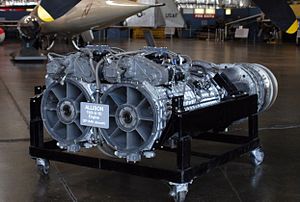Allison YT40
| T40 | |
|---|---|
 |
|
| T40-A-10 at the National Museum of the United States Air Force | |
| Type | Turboprop |
| National origin | United States |
| Manufacturer | Allison Engine Company |
| Major applications |
A2D Skyshark Convair R3Y Tradewind Convair XFY Pogo |
| Developed from | Allison T38 |
The Allison T40, company designation Allison Model 500, was an early American turboprop engine composed of two Allison T38 power sections driving a contra-rotating propeller via a common gearbox.
The T40 concept originated at Allison in 1944, where design studies were carried out on a 4,000 shp (2,983 kW) turboprop engine. Taking advantage of this effort, the US Navy awarded Allison a contract for the design and development of a 4,100 shp (3,057 kW) turboprop engine. The resulting T40 combined two Allison T38-A-1 power sections side-by-side with a common reduction gearbox powering a contra-rotating propeller. Similar in layout to the Armstrong Siddeley Double Mamba, the T40 differed in that each engine drove both the forward and the rear propellers, unlike the Double Mamba, where each Mamba power section drove either the front or the rear propeller separately.
The T38-A-1 power sections each contained 17-stage compressors giving a pressure ratio of 6.3:1, eight combustion chambers, and four-stage turbines. A combining reduction gearbox was driven via extension shafts from the power sections. Each transmission shaft incorporated a clutch to allow the power sections to be run independently.
Accessories included a Master Control Unit, mounted above the compressors; and an air driven starter on the gearbox. The compound reduction gear had an overall reduction ratio of 15.75:1 and incorporated an airscrew brake to prevent windmilling when the engine was stopped. Anti-icing for the air intakes was supplied by compressor bleed air. The contra-rotating propeller consisted of two 14 ft (4.3 m) three-bladed Aeroproducts propellers fitted to concentric shafts.
Testing of the XT40 began on 4 June 1948, revealing some major vibration problems from the reduction gearbox due to mis-matched noise frequencies caused by poorly designed gear teeth. The de-coupling system, designed to disconnect a power section in the event of failure worked successfully. During a run in a test cell one power section developed a major oil leak and an attempt to shut it down failed because the engine carried on running on the leaking oil. After many attempts to shut it down the offending power section could only be shut down by destroying the compressor with buckets of nuts and bolts thrown down the intake, proving the de-coupling system.
First flight test of the T40 was in the Convair XP5Y flying boat on 18 April 1950 fitted with four T40-A-4 developing 5,250 shp (3,915 kW). Service use of the T40 revealed problems with integrity of the propellers and gearboxes with at least one instance each of a propeller breaking free and a gearbox separation. One unusual problem was discovered during ground running of the Republic XF-84H Thunderscreech turboprop powered fighter; the special transonic 3-bladed single propeller set up harmonics that proved to be harmful to humans within a certain distance from the aircraft.
...
Wikipedia
